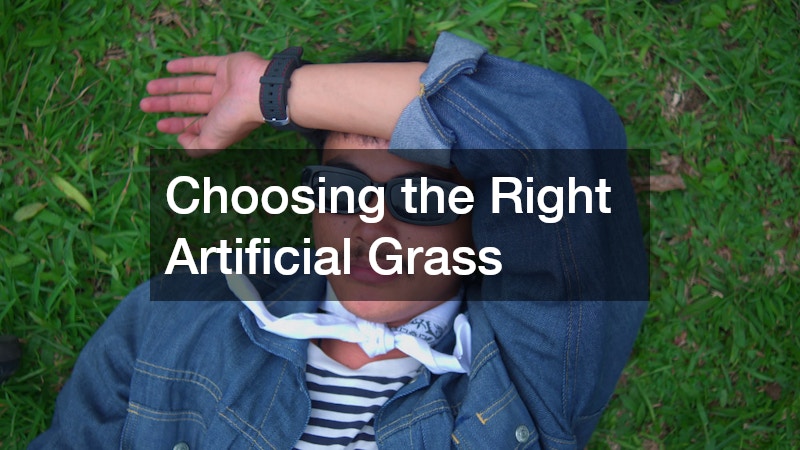Artificial grass has become an increasingly popular choice for homeowners, businesses, and sports facilities looking for a low-maintenance, durable, and visually appealing alternative to natural lawns. With advancements in design and technology, today’s synthetic turf is more realistic and versatile than ever before. However, not all artificial grass is the same. Different types are made to serve unique purposes, from enhancing curb appeal to withstanding heavy foot traffic on athletic fields.
Below, we’ll explore four common types of artificial grass and the benefits each one brings.
1. Landscape Artificial Grass
Landscape artificial grass is one of the most widely used varieties. Designed to replicate the look and feel of natural lawns, this type is ideal for residential yards, commercial properties, and recreational areas.
Its fibers are typically softer and more flexible, making it pleasant to walk or lounge on. Many versions also feature a mix of colors—light, dark, and even brown tones—to mimic the natural variations found in real grass. Some models are built with added thatch layers to enhance realism.
The primary appeal of landscape turf lies in its aesthetic value. It gives homeowners a lush, green yard year-round, regardless of weather conditions. Unlike natural lawns, it doesn’t require mowing, watering, or fertilizing, making it a time-saving and eco-friendly choice. Landscape artificial grass also works well for creative projects such as rooftop gardens, patios, or pool surrounds.
2. Pet-Friendly Artificial Grass
For pet owners, there’s artificial grass designed specifically with furry companions in mind. Pet-friendly turf is engineered to handle the wear and tear caused by running, playing, and digging, while also being easy to clean.
This type often includes features such as:
-
Drainage systems: Quick-draining backing that prevents puddles and allows pet waste to wash away easily.
-
Durability: Stronger fibers that resist damage from scratching or digging.
-
Odor control: Some varieties are infused with antimicrobial properties to help neutralize odors.
Pet-friendly artificial grass helps create a safe and comfortable play area for dogs and cats while keeping the yard neat and mud-free. It’s a practical option for kennels, veterinary clinics, or backyard dog runs. Plus, because it doesn’t rely on soil, pets won’t track dirt or allergens into the home.
3. Sports and Athletic Artificial Grass
Sports facilities often rely on artificial grass to maintain consistent playing surfaces. Athletic turf is designed to withstand intense activity and heavy foot traffic without losing its integrity. It’s commonly used in football, soccer, baseball, and multipurpose fields.
The fibers in sports turf are typically shorter and denser than those found in landscape grass. This design helps maintain stability for athletes while reducing the risk of slips or injuries. Some systems include shock-absorbing pads beneath the surface to add cushioning and support joint health.
In addition to outdoor stadiums, athletic artificial grass is frequently installed indoors for training centers, gyms, or recreational sports complexes. It allows for year-round use, regardless of weather, and requires less maintenance compared to natural grass fields, which often struggle with uneven wear and bare patches.
4. Putting Green Artificial Grass
Golf enthusiasts often install putting green artificial grass in their backyards or practice facilities. This type is crafted to replicate the smooth, short surface of professional golf courses, providing a reliable playing experience.
Putting green turf usually features tightly woven fibers that create a flat, even surface. The pile height is shorter than other types, ensuring a consistent roll of the ball. Advanced designs allow users to customize slope, speed, and contour to suit their training needs.
While primarily used for golf, this turf can also double as a decorative feature in outdoor spaces. It provides a sleek, manicured look that blends well with landscaping. For those who enjoy entertaining guests, a home putting green adds both functionality and visual appeal to the yard.
Choosing the Right Artificial Grass
Selecting the best type of artificial grass depends on how the space will be used. For everyday curb appeal, landscape turf offers a natural look with minimal maintenance. Pet-friendly options create a durable, clean play space for animals. Athletic turf ensures reliable performance for sports and recreation, while putting green grass caters to golf lovers looking for professional-quality practice areas.
Each type serves a unique purpose, but they all share the same core benefits: durability, low maintenance, and year-round greenery. By understanding the different options, homeowners and businesses can make informed decisions that fit their lifestyle and needs.
Artificial grass is more than just an alternative to natural lawns—it’s a versatile solution that adapts to different environments and activities. Whether it’s creating a lush backyard retreat, providing a safe play area for pets, supporting athletic performance, or enhancing a golf game, there’s a type of turf suited for every purpose.
As innovations in design continue, artificial grass will only become more realistic and functional, making it a smart investment for those who value beauty, convenience, and durability in their outdoor spaces.




